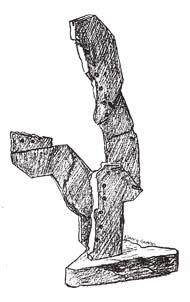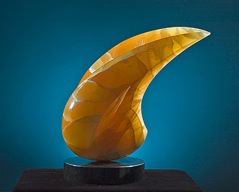
Home » Journal Articles » Thoughts & Opinions » Laura Alpert: Teacher of Three Dimensional Design – Jan/Feb 1999
In the March/April 1998 issue, I discussed the Golden Mean method of measuring proportions by geometry. Proportion is a function of design, along with balance, rhythm, repetition, variation, contrast, and gradation. In preparation for a series in design, I am presenting to you a biography of Laura Alpert.

As fortune would have it, Laura Alpert came to the 1998 Camp Brotherhood Symposium to teach a workshop in Design. She has a fresh approach to analyzing design, acquired through much research and the novel way she teaches design to beginning students at the University of Oregon; so much fresher than many textbooks covering introduction to design.
Laura Alpert entered the world of sculpture and received her degree at a time when there was not much instruction in terms of three dimensional design. In order to teach it, she researched the history and principles of design, especially three dimensional design. She studied many historical sources from 3D work that the French Academy had written. When the German Bauhaus group brought forth their new ideas of design in the 1880’s, design as a separate entity didn’t exist, certainly not in the classical textbooks of the time.
Laura taught Art at Indiana University from 1976 to 1979 and participated in faculty classes. She taught the introductory program, Freshman Design. In preparation, she “played” with balsa wood and cardboard and refined the course. She developed a set of simple, understandable steps, which could ultimately be taken in a thousand directions. The result was that students formed a good ability to visualize a broad vocabulary of space and form. They were provided with a checklist, some of which included “What’s happening with … ” and “Relationship between forms …. ” They were to use this when they ran into a problem or as a starting point to generate ideas. These simple ideas cover a wide, diverse range. Another item ·00 the checklist was “Do you want to be dynamic or direct?,” causing the student to consider whether the piece should be at an angle-neither vertical nor horizontal – creating motion (dynamic), or vertical or horizontal, creating stability (direct).
In terms of design, Laura likes to do things that are slightly out of the norm-unexpected-“visually balanced but not perfectly balanced balanced. Unpredictable.”
During the 1998 Camp Brotherhood Symposium, Laura worked on a piece made of multiple marble sections fastened together. At first, pins wouldn’t hold the sections. But using a chainsaw, she slotted the pieces and fastened them together using pins, and it worked. See the accompanying illustration.
The University of Oregon in Eugene offers credit for the NWSSA Symposia. Laura was at the Camp Brotherhood Symposium as head of the University’s Department of Fine and Applied Art, as well as to teach us design. Tom Urban, of the University, was there as well. Tom is director of an independent on campus, and he teaches in the Art Craft Center Department.



We need some kind of descriptive text here.